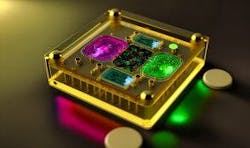Photonic Integrated Circuits: Advancing Data Processing
In our daily lives, the underpinnings of modern technology, including smartphones, computers, and even medical diagnostic tools, rely heavily on integrated circuits (ICs). However, traditional electronic ICs face limitations in terms of bandwidth, speed, and energy efficiency due to their reliance on electrons. To overcome these challenges and usher in a new era of enhanced performance, researchers and engineers are turning to Photonic Integrated Circuits (PICs), leveraging the speed and efficiency of photons over electrons.
Understanding Photonic Integrated Circuits
- Transitioning from Electronics to Photonics: Unlike conventional ICs, which transmit data using electrons, PICs utilize photons for faster and more efficient data processing. By harnessing the inherent advantages of light, such as minimal interference and high-speed transmission, PICs represent a paradigm shift in integrated circuit technology.
- Components and Functionality: A typical optical IC comprises laser diodes, waveguides, filters, and gain media, all integrated onto a flat substrate, usually a silicon wafer. Waveguides, serving as the optical equivalent of metallic wires, manipulate light through principles like total internal reflection. This arrangement facilitates high-speed transmission with minimal energy loss, making PICs exceptionally powerful and efficient.
- Challenges and Progress: Despite their immense potential, PICs are still in the developmental stage, with higher costs and limited availability compared to traditional ICs. Additionally, PICs occupy larger physical footprints, albeit still on a micron scale. However, ongoing advancements and the integration of micro-optics are driving the miniaturization of PICs, paving the way for compact, lightweight systems with broader accessibility.
Applications of Optical ICs
- Communication: PICs play a pivotal role in optical communications, offering enhanced reliability and transmission capacity compared to traditional ICs, particularly in fiber and free-space optical communication systems.
- Optical Metrology: Fields such as LIDAR and fiber-optical sensors benefit from the precision and sensitivity offered by PICs, enabling advancements in measurement and detection technologies.
- Quantum Computing: The unique properties of PICs make them promising candidates for quantum computing and cryptography, offering potential breakthroughs in secure communication and computational power.
- Biosensing: Photonic integrated chip biosensors revolutionize medical diagnostics by enabling rapid, label-free testing with unprecedented sensitivity. These sensors, often based on silicon nitride substrates, detect minute changes in refractive index, providing real-time, reliable results crucial for healthcare applications.
As research and development in the field of photonic integrated circuits continue to advance, the transformative potential of these technologies becomes increasingly evident. From revolutionizing telecommunications to enabling cutting-edge biosensing applications, PICs represent a cornerstone of future innovation, poised to reshape diverse industries and enhance the way we interact with technology.
Contact Shanghai Optics today! We’d be more than happy to discuss your projects and how to best bring them to fruition.



